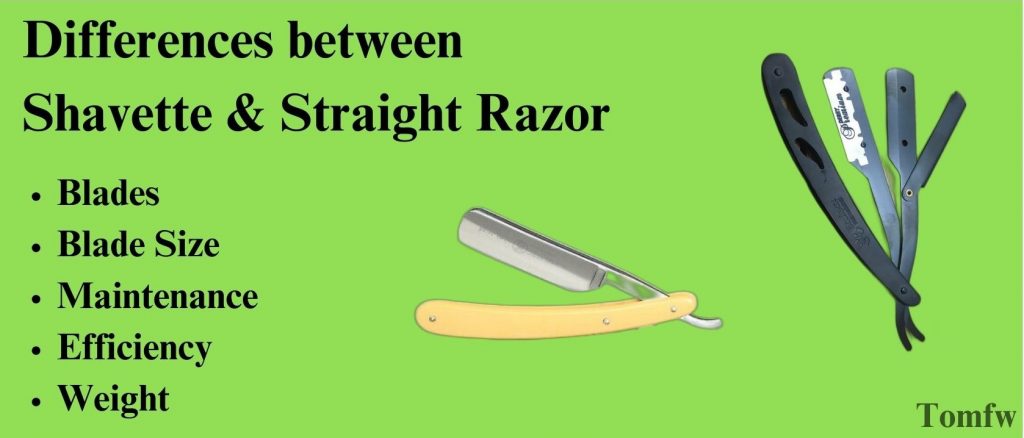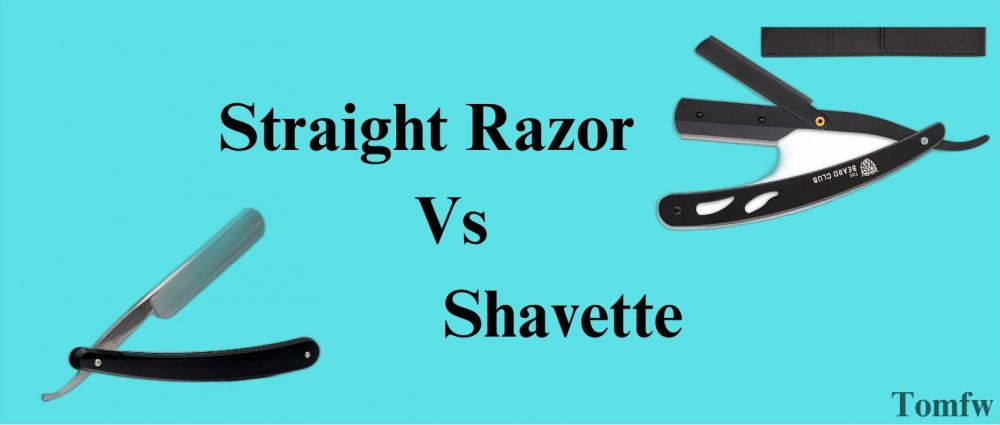Have you ever wondered what the difference is between a straight razor and a shavette? While both tools boast a sharp edge and promise a close shave, they cater to distinct preferences. The straight razor, steeped in history, demands respect with its honed blade and intricate shaving ritual. It represents a timeless connection to the art of traditional grooming, promising an unparalleled level of closeness.
The shavette, on the other hand, offers a modern take on the classic design, providing convenience with its replaceable blades. It’s a more accessible option, requiring less maintenance while still delivering a satisfyingly smooth shave.
This blog will delve into the world of these two razors together (straight razor vs shavette), exploring their features, advantages, and drawbacks. Whether you’re tempted by the precision and tradition of the straight razor or the ease of the shavette, let’s discover which one might be the perfect fit for your shaving journey.
Table Of Content
The History of the Straight Razor
The exact beginnings of the straight razor remain a mystery, but there is evidence of primitive shaving devices from 1600 to 1000 BC in ancient Egypt. These devices underwent numerous transformations over the ages, culminating in the modern straight razor that emerged in Sheffield, England, in the 18th century. The advancements in steel production techniques by Benjamin Huntsman were essential for enhancing the razor.
For two hundred years, straight razors were the preferred choice for shaving. Nevertheless, their popularity began to wane following the introduction of the safety razor in the late 19th century and the electric razor in the mid-20th century. Despite this decline, straight razors still have a loyal fan base today, esteemed for their classic charm and the exceptional shave they deliver.
The History of the Shavette
The term “shavette” might seem a bit peculiar, but its origins are straightforward. The name comes from the renowned German cutlery manufacturer Dovo Solingen, also known for its high-quality straight razors. When Dovo introduced a razor with a similar design to a shavette’s blade, a traditional straight razor featuring replaceable blades, they coined the term “shavette” to distinguish it.
This innovation was a game-changer. It retained the familiar look and feel of a straight razor but eliminated the need for honing and sharpening. Instead, dull blades could be quickly swapped out for new, crazy sharp ones.
While there are now many shavette makes, the term has become synonymous with this style of razor, where a blade holder secures a portion of a disposable razor blade.
Difference Between a Straight Razor vs Shavette

While both straight razors and shavettes occupy a niche in the world of wet shaving, they cater to distinct preferences. Here’s a breakdown of their main difference:
- Shavettes utilize replaceable blades, while straight razors possess solid blades.
- Straight razor blades are larger than a shavette’s blades.
- Straight razor blades require honing and stropping; shavette blades are disposable.
- Shavettes are preferable for commercial use and for sharing razors amongst friends.
- Shavettes are lighter and lack the weight of a straight razor.
Blades
This is the main distinction.
A straight razor boasts a single, honed blade that requires regular stropping and sharpening to maintain its sharpness.
In contrast, a shavette utilizes replaceable blade blades, similar to those found in disposable razors. This eliminates the need for sharpening but introduces the cost of buying new blades.
Blade Size
Straight Razor: Boasts a significantly longer blade, providing a wider cutting surface with each stroke. The substantial blade width enables greater efficiency and potentially a closer, smoother shave with fewer passes.
Shavette: Employs shorter disposable blades, usually half the size (or less) of a standard double-edge safety razor blade. This results in a slightly different shaving feel compared to a traditional straight razor’s blade.
Maintenance
Straight Razor: Requires regular stropping with a leather strop to keep the blade’s edge aligned and less frequent honing on stones to restore the blade edge. This maintenance ritual is part of the appeal and skill of straight razor shaving.
Shavette: No honing or stropping needed! When the shavette blade becomes dull, you simply dispose of it and insert a fresh, sharp one. This convenience makes it a low-maintenance shave-ready option.
Efficiency
Straight Razor: In the hands of a skilled user, a well-honed straight razor can deliver the closest, most efficient shave possible due to the long, sharp blade edge.
Shavette: Provides a satisfying shave for most users, though it might not quite match the closeness achievable with a perfectly sharpened straight razor.
Weight
Straight Razor: Possesses a solid, more substantial weight due to its full-length blade and sturdy handle. This provides a sense of control and balance for some users.
Shavette: Much lighter in weight since it only houses a portion of a disposable blade. The lightweight build can feel easier to maneuver, though it lacks the heft favoured by some traditional straight razor enthusiasts.
Ultimately, the choice between a Straight Razor vs Shavette comes down to personal preference. If you are drawn to the tradition and potential for an exceptionally close shave, the straight razor might be the path for you. If you prioritize convenience and a lower learning curve, the Shavette could be a better fit.
Straight Razor vs Shavette: Pros & Cons
Deciding between a Straight Razor vs Shavette involves weighing their unique strengths and limitations. Both offer a distinct shaving experience compared to modern cartridge razors, but each comes with its pros and cons.
Let’s explore these benefits and considerations to help you determine which razor might better suit your needs and shaving lifestyle.
Pros of Shaving with a Shavette
- Convenience: The Shavette shines in ease of use. There’s no need for honing or stropping; simply insert a fresh, sharp blade and you’re ready to go.
- Less Learning Curve: While mastering any razor takes some practice, the Shavette has a gentler learning curve than a straight razor. This makes it a great entry point into the world of single-blade shaving.
- Hygienic: Disposable blades eliminate potential issues associated with maintaining a honed straight razor’s edge over time.
- Travel-Friendly: Compact size and no need for strops or honing equipment make the Shavette ideal for travel.
- Cost-Effective: While the initial investment in a Shavette might be slightly more than a safety razor, the cost of replacement blades is generally lower than expensive multi-blade cartridge refills.
Cons of Shaving with a Shavette
- Not as Close (for everyone): While a Shavette delivers a satisfying shave, it might not always match the unparalleled closeness achievable with a perfectly honed straight razor in skilled hands.
- Blade Replacement: The need to replace the blades regularly can be seen as an inconvenience, and there’s an ongoing cost to consider.
- Blade Quality Varies: The performance of a Shavette relies on the quality of the blades you use. Less expensive blades might feel less sharp or dull quicker than premium options.
- Lacks the Tradition: For some, part of the appeal of wet shaving is the connection to the time-honoured ritual of straight razor shaving. A Shavette, while similar in aesthetic, lacks this historical legacy.
- Potential for Waste: Disposing of dull blades creates some environmental impact compared to maintaining a single straight razor blade over a long period.
Pros of Shaving with a Straight Razor
- Unparalleled Closeness: A well-honed straight razor, wielded by a skilled user, can achieve the absolute closet shave possible. This translates to fewer ingrown hairs and a smoother feel for longer.
- Exceptional Efficiency: The large blade and single-edge design allow for a very efficient shave, requiring fewer passes compared to multi-blade razors or even Shavette.
- Reduced Razor Burn: The single, sharp blade of a straight razor minimizes irritation and razor burn that can be caused by the tugging and pulling of multiple dull blades in cartridge razors.
- Long-Term Saving: While the upfront cost of a quality straight razor can be significant, it’s an investment that can last a lifetime with proper care. in the long run, it can be more cost-effective than continually buying disposable razors or Shavette blades.
- Satisfying Ritual: The process of honing, stropping, and shaving with a straight razor becomes a relaxing and meditative ritual for many users. It’s a moment of self-care and a connection to a time-honoured tradition.
- Sense of Accomplishment: Mastering the art of straight razor shaving requires dedication and practice. Achieving a close, comfortable shave with a straight razor brings a unique sense of accomplishment.
- Quality Construction: Straight razors are often crafted from high-quality steel and beautiful materials. Owning a well-made straight razor can be a source of pride and a lasting heirloom.
Cons of Shaving with a Straight Razor
- Steeper Learning Curve: Mastering a straight razor requires significant time, practice, and proper technique. There’s a risk of nicks and irritation until you develop muscle memory and control over the blade.
- Higher Maintenance: Straight razors demand regular stropping to maintain peak sharpness and periodic honing with whetstones to restore the edge angle. This ongoing maintenance can be a discouragement for some users.
- Higher Upfront Cost: Quality straight razors are an investment, often costing more than Shavette or Safety razors.
- Potential for Nicks and Cuts: Even with proper technique, there’s always a risk of nicks and cuts when using a sharp straight razor blade. This can be a dealbreaker for some.
- Not Ideal for Sensitive Skin: The aggressive nature of a straight razor might not be suitable for those with sensitive skin, potentially causing irritation or razor burn.
- Time Commitment: The Shaving ritual itself takes longer with a straight razor compared to using a modern cartridge razor. The stropping, shaving, and cleaning process requires dedicated time.
- Travel Considerations: Straight razors can be trickier to travel with. Some airlines have restrictions on carrying blades, and the stropping and cleaning routine might not be feasible on the go.
Straight Razor Examples
Shavette Examples
The models mentioned represent just a fraction of the shavette and straight razor options available. To explore more choices and discover top-rated razors tailored to your specific needs and preferences, click here. Our comprehensive guide will help you find the perfect shavette vs straight razor, to elevate your shaving experience.
FAQs:
1. Is a shavette better than a straight razor?
Not only are shavettes easier and cleaner as they do not need sanding — they also provide more cleaning as the blades can easily be removed and disposed of.
2. Why use a shavette?
For an advanced user, the razor shavette is ideal for beginners. This is because it offers the convenience of traditional straight razors and the cleanness and comfort of disposables. Shavers still have to learn to shave as they employ the same technology as the razor, but their absolute lack of maintenance is one major advantage.
3. What are the benefits of a shavette?
Advantages of Shavette:- No need to replace the blade for up to 5-6 shaves.
- No need to sharpen the blade edge like a straight razor and therefore no need to buy a razor sharpening belt.
- The Shavette and the blades are cheaper than a straight razor.
- Shavette is more lightweight than a straight razor so it’s more convenient to travel with it.
Conclusion
The question of whether a straight razor or a shavette is the better choice ultimately comes down to your individual needs and the shaving experience you seek. Both offer the potential for a close, satisfying shave along with a touch of classic shaving style.
If you’re ready to embrace the ultimate shaving challenge, invest in the skill and tradition of a straight razor. It’s a commitment, but the rewards of a perfect shave and a connection to the past are undeniable.
If you want the convenience of replaceable blades, appreciate the lower learning curve, and prioritize hassle-free maintenance, then a shavette is the ideal route.
Ultimately, there’s no single “right” answer. Exploring different options is part of the fun! Don’t be afraid to experiment and embrace the unique journey of finding your perfect shaving tool. The joy is discovering the art of a clean shave that aligns with your lifestyle preferences.

Reet Patel
As a college student, I understand the value of a polished appearance. My dedication to a well-groomed beard signifies the importance I place on self-presentation and consistency in my personal and professional life. My commitment to a well-maintained beard reflects my broader attention to detail. Whether in my studies or my appearance, I strive for precision and quality.







